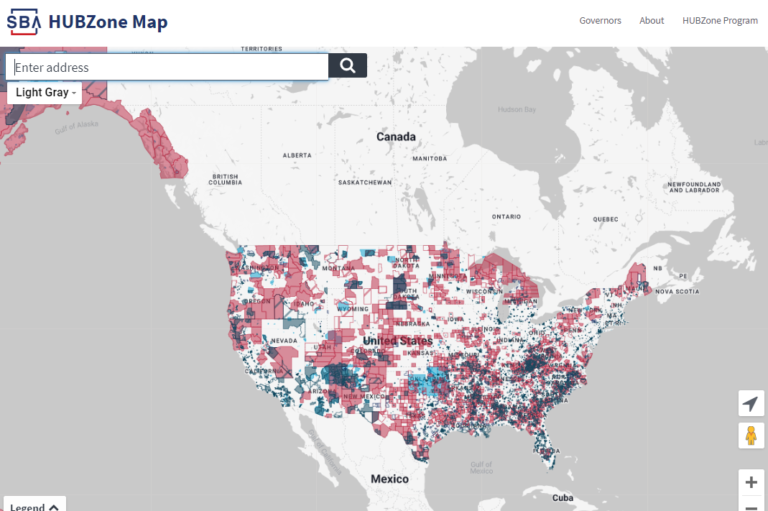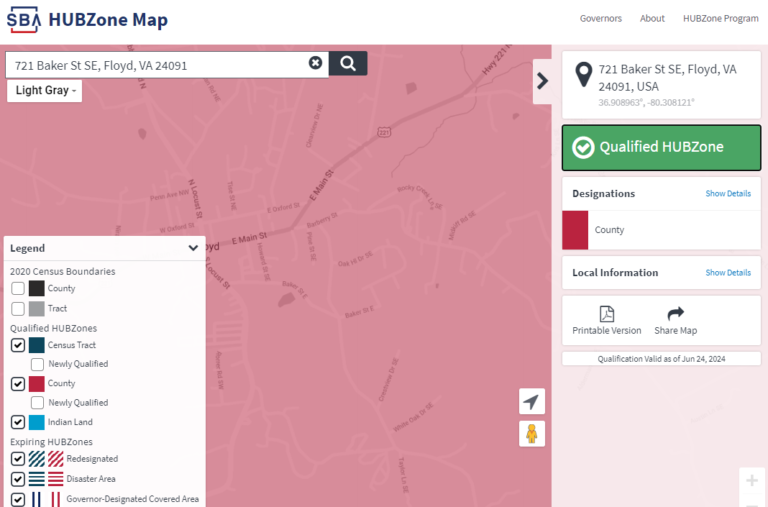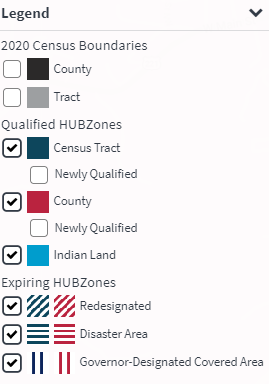Government contracting can open up a world of opportunities for small businesses, but there’s no denying that breaking into this market can be a challenge. However, there are programs created by the federal government to empower smaller businesses. HUBZone is one program in particular that is a powerful tool for leveling the playing field in some of the most underserved communities across America. By leveraging this program, your small business can gain the competitive edge needed to secure contracts.
In this article, we’re taking a closer look at the HUBZone map, what it is, and how its designations might impact your eligibility. We’re also sharing some of the recent expansions of the map and how these updates are determined. So keep reading to better understand how to use the HUBZone map, not only so you can confirm your eligibility but to also gain valuable insights for your contracting business.
What is a HUBZone area?
HUBZone stands for Historically Underutilized Business Zone. In simpler terms, it’s a geographically defined area designated by Congress as economically distressed. These areas often face high unemployment rates, lower median household income, and limited access to resources. Using Census Bureau data, the Small Business Administration (SBA, for short) aims to strengthen their economies and create opportunities for local businesses.
The SBA HUBZone map encompasses a diverse range of areas, each with its own designation. Understanding these categories is important as they will help you to determine the eligibility requirements for HUBZone certification and to win these types of government contracts. Here’s a breakdown of the HUBZone Designations:
- Qualified Census Tracts (QCTs): These are urban areas identified by the Census Bureau as having high social and economic needs. An example is a lower-income neighborhood within a larger city.
- Qualified Non-Metropolitan Counties (QNMCs): These are rural counties facing similar economic challenges as QCTs but with a lower population density.
- Qualified Indian Lands: Lands within the state of Oklahoma that are within the external boundaries of federally recognized Indian reservations automatically qualify as HUBZones.
- Qualified Disaster Areas: These are typically census tracts and counties that have been declared as major or catastrophic disaster areas by the President.
- Governor-Designated Covered Areas: These are areas outside of urbanized areas with a population under 50,000 and an unemployment rate significantly higher than the national or state average. Nominations for these areas come from governors and require SBA approval.
- Redesignated Areas: Finally, these are HUBZone areas that have lost their HUBZone status due to changes in income, poverty, or unemployment levels. This classification typically lasts three years to allow small businesses to adapt to the changes.
Head here to learn more about HUBZone Certification requirements and its benefits.
How do I know if I live in a HUBZone area?
To know if you live in a HUBZone location, you’ll want to use their map. Beyond confirming eligibility, the HUBZone map offers a wealth of information for small business owners. By exploring different areas, you can gain valuable insights into potential markets and identify locations with high concentrations of HUBZone businesses, fostering collaboration and strategic contracting partnerships.
Navigating the HUBZone map
Using the SBA HUBZone map is quite a simple process following the instructions below:
1. Visit the SBA’s HUBZone map here.

2. Input your business address into the designated search bar and click “Search.”

3. The map will automatically zoom to that location and display a color-coded designation and additional details.

HUBZone map legend

In the HUBZone map, you’ll also find a legend that provides a key for interpreting these color codes. Qualified HUBZone locations mean businesses with a physical presence in these areas are eligible to pursue certification:
- Qualified census tracts (navy)
- Qualified counties (pink)
- Qualified Indian land (light blue)
The rest represent expiring HUBZones that are nearing the end of their designation and are scheduled for reevaluations:
- Redesignated census tract (diagonal navy stripes)
- Redesignated county (diagonal pink stripes)
- Disaster area census tract (horizontal navy stripes)
- Disaster area county (horizontal pink stripes)
- Governor-designated tract (vertical navy stripes)
- Governor-designated county (vertical pink stripes)
HUBZone map and its update cycle
The HUBZone Map is not a static list. Every five years, it undergoes a large update based on the most recent data collected by the U.S. Census Bureau. This periodic refresh ensures the program’s continued relevance and reflects the most current economic realities throughout the country.
The most recent update was July 1st, 2023, and utilized data from the 2020 Census. The next anticipated update is scheduled for July 2028. This most recent update however aimed to expand the program with these two key changes:
- The update included 3,732 newly qualified communities to the more than 20,000 HUBZone areas across the United States and its Territories.
- 74 new rural communities across New York, New Mexico, South Dakota, and Michigan received HUBZone designation as Governor-designated Covered Areas bringing the total number to 308 areas across 17 states.
This five-year cycle guarantees the HUBZone program remains aligned with the changing economic landscape and ensures the areas with the greatest need for economic revitalization are effectively targeted.
Start your headache-free HUBZone certification today
If you’re ready to start earning contracts and money today, getting your HUBZone certification is a great way to start. The government contracting process can sometimes be complicated and frustrating. So at FAMR, we’re here to make it easy for you. Our years of experience working with federal contractors and the SBA means that you’ll have an expert team in your corner to make sure you maximize your contracting opportunities and profit.
Connect with us online today or give us a call to take the first step toward unlocking more opportunities!


